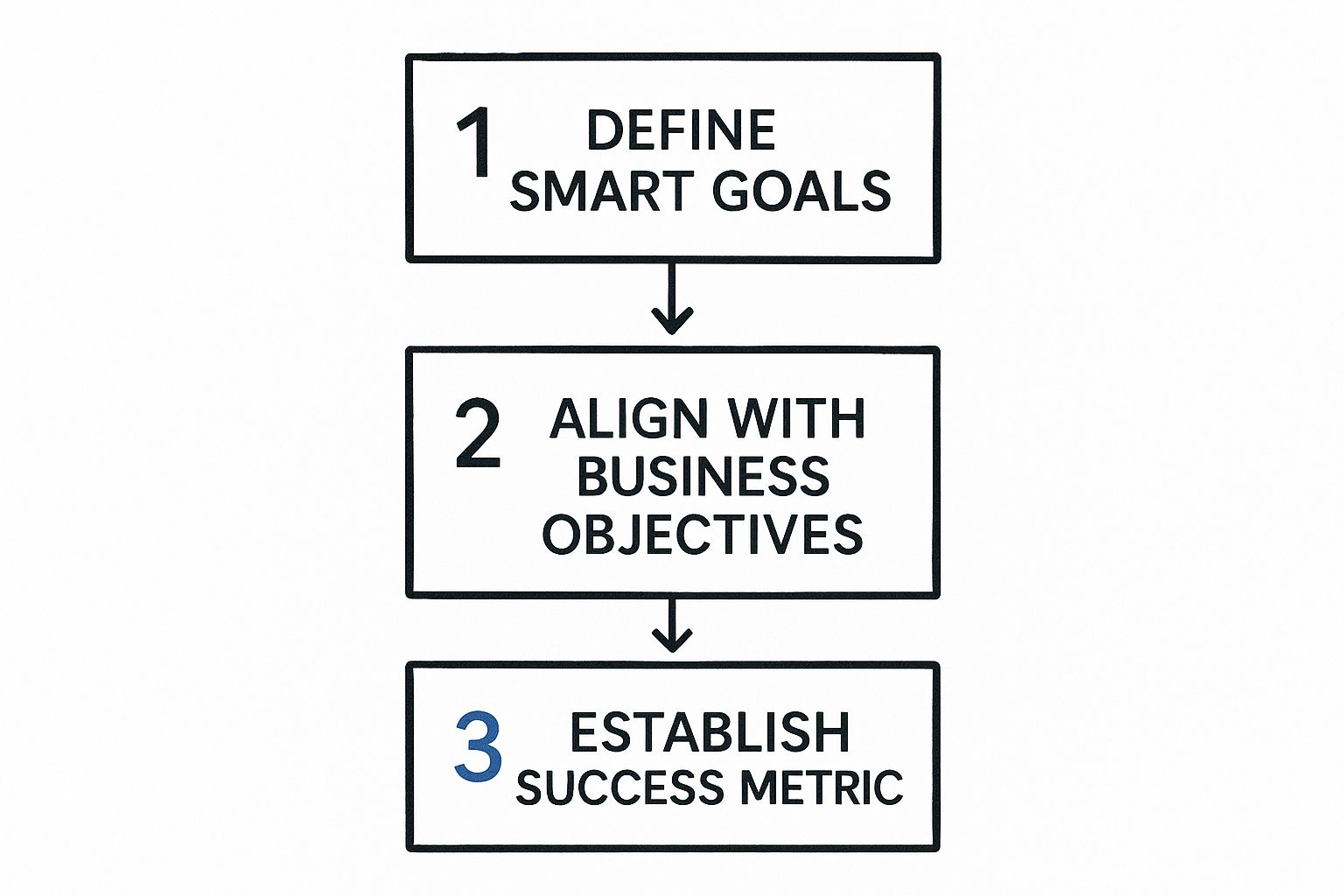A strong content strategy for social media transforms your online presence from random posting into purposeful communication. Instead of sharing content that gets lost in the feed, a clear strategy ensures every post contributes to a goal whether that’s boosting brand awareness, building community, or driving sales.
If you’ve ever wondered what is content strategy for social media, think of it as your game plan defining who you’re talking to, what message you’re sending, and how you’ll measure success. You can also explore how social media and content strategy work together to create consistent brand messaging across every platform.
Building Your Foundation for Social Media Success
Before you even think about what to post, you need to lay some serious groundwork. A solid foundation is the difference between a social media presence that fizzles out and one that delivers real, measurable results. It all starts with getting crystal clear on who you’re talking to and what you’re trying to accomplish.
Know Your Audience
You can’t connect with people you don’t understand. Go beyond demographics — use analytics to identify who follows you, what topics they engage with, and when they’re most active. Explore where they spend time online (LinkedIn, Reddit, or niche communities) and study the questions they ask. This helps you craft content that resonates instead of blending in.
Set Goals That Drive Real Growth
General goals like “get more followers” don’t work. Align your social media objectives with real business outcomes.
Example:
“Increase Instagram engagement by 15% this quarter through interactive Stories and user-generated content.”
Using the SMART framework (Specific, Measurable, Achievable, Relevant, Time-bound) turns your intentions into an actionable roadmap.

Analyze Your Competitors to Find Your Edge
Your competitors are a treasure trove of insights, and you should absolutely be paying attention. Analyzing their social media isn’t about copying their every move. It’s about finding the gaps they’ve left wide open for you.
What’s their best-performing content? Look for recurring themes and formats—like videos, carousels, or simple text posts—that get the most love from their audience. Equally important, what falls flat? Their missteps can highlight exactly where you can shine.
Expert Tip: Don’t just watch the industry giants. Keep an eye on the smaller, scrappy brands in your niche. They’re often more nimble and willing to experiment, which can give you a peek at fresh tactics and content ideas you can adapt for your own strategy.
A solid strategy is non-negotiable in such a crowded space. With an estimated 5.42 billion people on social media in 2025 and the average user juggling nearly seven different platforms a month, you have to be strategic to cut through the noise.
These foundational pillars are crucial for building a strategy that works. Here’s a quick look at how they fit together.
Core Components of a Modern Social Media Strategy
| Pillar | Objective | Key Action |
|---|---|---|
| Audience Definition | To deeply understand who you’re talking to. | Create detailed user personas based on analytics and community research. |
| Goal Setting | To align social media efforts with business outcomes. | Define SMART goals for engagement, reach, and conversions. |
| Competitive Analysis | To identify opportunities and market gaps. | Regularly audit competitors’ content to find what works and what doesn’t. |
| Content Creation | To produce valuable, engaging, and relevant posts. | Develop content pillars and a mix of formats (video, images, text). |
| Scheduling & Publishing | To maintain consistency and optimize timing. | Use a content calendar to plan posts and publish when your audience is active. |
| Measurement & KPIs | To track performance and prove ROI. | Monitor key metrics and adjust the strategy based on data-driven insights. |
By mastering these components, you’re not just posting—you’re building a powerful communication engine for your brand.
As you build out your plan, checking out some powerful content strategy examples can be a great way to get inspired. Putting in this upfront work—knowing your audience, setting clear goals, and sizing up the competition—ensures every post you publish is a calculated move toward success.
Choosing the right platforms
The fear of missing out is a powerful motivator, but it makes for a terrible content strategy for social media. The single biggest mistake I see brands make is trying to be everywhere at once. When you spread your resources that thin, you don’t make a strong impression anywhere—you just end up making a weak one everywhere. The real goal is to focus your energy where it will actually make a difference.
This all starts with the audience research you’ve already done. You know who they are, but the critical question is where do they hang out online? And it’s not just about matching platform demographics to your customer profile. You have to go deeper and understand the context of why they’re on each network. Are they scrolling through LinkedIn for career growth, browsing Instagram for visual inspiration, or killing time on TikTok?
The right platform isn’t just where your audience has an account; it’s where they are actively open to hearing what your brand has to say.
Aligning Your Brand with the Right Platforms
Picking your core social media channels is all about finding that sweet spot where your audience’s online habits meet your brand’s natural strengths. A B2B software company will almost certainly find its footing on LinkedIn, where detailed case studies and thought leadership articles are valued. On the flip side, a direct-to-consumer fashion brand will get much more mileage from visually stunning content on Instagram and TikTok.
As you evaluate platforms, ask yourself these questions:
-
Where does my audience engage most?
-
What formats (video, text, carousel) fit my brand’s strengths?
-
What can my team realistically manage consistently?
Don’t just take my word for it. An Econsultancy study found that 67% of marketers who create custom strategies for each platform reported better ROI. This just proves that a one-size-fits-all approach doesn’t work; tailoring your content pays off.
Defining Your Core Content Pillars
Once you’ve figured out where you’re going to post, you need to decide what you’re going to talk about. This is where your content pillars come into play. These are the 3-5 core themes that your brand will own, day in and day out. Think of them as the guardrails for your content—they ensure every single post is relevant and reinforces what your brand stands for.
Imagine your brand has its own magazine. Your pillars are the main sections. For a fitness apparel brand, those pillars might look something like this:
-
Workout Tips – Inspire followers to stay active.
-
Product in Action – Show real use cases and results.
-
Nutrition & Wellness – Provide practical lifestyle advice.
-
Community Stories – Share authentic customer transformations.
With clear pillars, you can avoid random posting. Any time a new idea pops up, you simply ask, “Does this fit under one of our pillars?” If not, you can probably scrap it. This structure is the absolute backbone of a consistent and recognizable brand on social media.
Your content pillars are the guardrails of your content strategy for social media. They keep your messaging focused, prevent creative burnout, and build a predictable, trustworthy experience for your audience.
Bringing Your Pillars to Life
With your pillars locked in, brainstorming becomes so much easier. You’re no longer staring at a blank calendar wondering what to post. Instead of a vague goal like “create more video content,” you have a structured starting point.
Let’s take that “Community Stories” pillar from our fitness brand example. Right away, it sparks specific ideas:
- A weekly “Customer Spotlight” feature.
- A user-generated content campaign using a unique branded hashtag.
- An Instagram Stories Q&A with a brand ambassador.
- Short video testimonials from loyal customers.
See how every idea ties directly back to a strategic theme? This ensures your social channels tell a cohesive story instead of feeling like a chaotic jumble of posts. It’s that kind of focus and clarity that ultimately turns casual followers into a genuinely loyal community.
Creating and Curating Content That Connects

Alright, you’ve picked your platforms and defined your content pillars. Now for the fun part: actually making the stuff your audience will see, love, and share. Let’s be real—a successful social media strategy isn’t about having a Hollywood budget. It’s about creating a consistent and valuable experience.
You need to start thinking more like a media company and less like a marketer. Your feed should become a go-to spot where people know they’ll find something useful, whether that’s a bit of inspiration, a solid piece of advice, or just a good laugh. To do that, you need a healthy mix of content that grabs attention and builds real trust.
To maximize your effort, reuse top-performing posts in different formats — for instance, turn a carousel into a short video or a blog quote into a tweet. For more ideas, check out this guide on building a content repurposing strategy that extends your reach across multiple channels.
Mastering the Art of the Content Mix
If all you post are static images, your feed will get stale—fast. To keep people genuinely interested, you need variety. Think about how different formats can bring your content pillars to life in fresh ways.
- Bite-Sized Videos (Reels, TikToks, Shorts): These are absolute gold for showing off your brand’s personality. Use them for quick tips, behind-the-scenes moments, or fast and fun product demos.
- Interactive Carousels: Perfect for breaking down bigger ideas into easy-to-digest slides. I love using them for step-by-step guides, mini-tutorials, or walking through different product features.
- Insightful Text Posts: Never underestimate the power of a well-written post on platforms like LinkedIn or Threads. This is your chance to build authority and kickstart some really meaningful conversations.
- Authentic User-Generated Content (UGC): Sharing posts from your actual customers is probably the most powerful form of social proof out there. It’s a genuine endorsement, and that’s far more convincing than any ad you could run.
Mixing up your formats keeps things from getting boring and caters to how different people like to consume content. Some scroll for videos, others prefer to read. Give them both, and you’ll expand your reach. For a deeper dive, check out our guide on content planning for social media.
The 80/20 Rule for Building Trust
One of the best frameworks I’ve ever used is the 80/20 rule. It’s incredibly simple: 80% of your content should give value, and only 20% should be directly promotional.
Value-driven content is all about educating, entertaining, or inspiring your audience without asking for anything in return. Think helpful tutorials, a funny industry meme, or a customer success story. This is how you stop being just another brand and start building a real community.
The other 20% is where you can make your ask—talk about your products, announce a sale, or send people to your website. Because you’ve spent most of your time giving, your audience will be way more open to hearing your pitch when you finally make it.
Your social media should feel like a helpful resource, not a constant sales pitch. Lead with value, and you’ll become a trusted hub people actually want to follow.
The Power of Curation and AI
Creating original content is key, but it doesn’t have to be the only thing you do. Content curation finding and sharing great content from other sources is a smart move. It shows you have your finger on the pulse of your industry and positions you as a go-to expert.
Sharing an insightful article from a non-competing thought leader or a relevant news story shows you’re paying attention. Just always, always give credit where it’s due.
On top of that, AI has become a game-changer for content creation. In fact, by 2025, over 71% of social media marketers worldwide had already brought AI tools into their workflow for everything from brainstorming ideas to optimizing posts.
The AI tools built right into Postiz, for instance, can help you generate ideas and even draft captions, which frees you up to focus on strategy. And as you diversify your content, don’t forget about audio. Exploring tools like free AI audio generators can help you create unique soundbites for your posts and videos, adding another layer of engagement.
Writing Captions That Convert
Your visual might stop the scroll, but it’s the caption that drives action. A great caption does more than just describe the photo; it adds context, sparks a conversation, and tells people what to do next.
Here are three quick tips I swear by for better captions:
-
Start strong with a question or bold statement.
-
Keep sentences short and scannable.
-
End with a call-to-action (CTA): invite comments, shares, or link clicks.
Organizing Your Social Media Content Calendar
Let’s be honest, consistency is the secret sauce to winning on social media. It’s how you turn casual scrollers into a real community that actually trusts your brand and looks forward to what you have to say. A well-oiled content calendar is your best friend here, helping you ditch the daily “what do I post?!” panic.
Think of it as the master blueprint for your entire social media plan. It takes all those great content pillars and brainstormed ideas and turns them into a concrete, manageable workflow. This isn’t just about plugging posts into a spreadsheet; it’s about building a system that saves you a ton of time and keeps your message sharp and consistent.
A content calendar keeps your team organized and ensures you never run out of ideas. Learn step-by-step how to create a content calendar for social media to streamline your publishing workflow and stay consistent all year round.
Mapping Out Your Posting Schedule
First things first, zoom out. Stop thinking day by day and start looking at your content in weekly or even monthly chunks. A monthly view is a game-changer because it gives you that bird’s-eye perspective. You can easily plan around big company announcements, product launches, or seasonal campaigns.
A great starting point is to assign your content pillars to specific days of the week. For instance, if you’re a financial wellness brand, your week might look something like this:
Assign themes to each weekday to stay organized, Example:
- Monday: Educational tip
- Wednesday: Behind-the-scenes
- Friday: Customer success story
This simple structure creates a rhythm. Your audience starts to know what to expect and when, which is huge for building loyalty. It also makes your job way easier because you’re not starting from scratch every single time you need an idea.
Once you have that basic framework, you can start layering in other key dates. A truly effective calendar accounts for everything from major holidays like New Year’s down to those fun, niche social media holidays like #NationalCoffeeDay. Planning for these in advance means you can create high-quality, relevant content instead of scrambling to throw something together at the last minute.
Embracing Automation and Smart Scheduling
A plan is useless if you can’t stick to it. This is where scheduling tools become absolutely essential. Manually publishing every single post isn’t just a time sink; it’s a surefire way to burn out. Using a platform like Postiz can completely overhaul your workflow for the better.
Imagine dedicating just one afternoon to writing and designing all of next week’s posts. By batching your work like this and loading it into a scheduler, you buy back hours of your time. This frees you up to focus on the things that really move the needle, like engaging with your community and analyzing what’s actually working.
A content calendar isn’t about boxing in your creativity—it’s about building the structure that lets your creativity thrive. When you handle the logistics upfront, you free up mental space for the strategic work that makes a real impact.
Smart scheduling is also about more than just convenience; it’s about making sure your content gets seen. The right tools can show you the peak times when your audience is most active. Publishing your best stuff during these golden hours can seriously boost your reach and engagement, making sure your hard work doesn’t get lost in the noise.
Automating posts saves time and ensures consistency. Use a LinkedIn post scheduler like Postiz to batch, plan, and publish content at the best times for engagement.
Building and Managing Your Calendar
So, what does a good calendar actually look like? It can be as simple as a Google Sheet or as powerful as a dedicated project management tool. The key is making sure it captures the right information to keep you and your team organized. For a deep dive, we’ve got a ton of practical advice in our guide on how to create a content calendar for social media.
Here’s a quick rundown of the essential components your calendar needs to keep everyone on the same page and your content flowing smoothly.
Essential Calendar Components
| Field | Purpose | Example |
|---|---|---|
| Publish Date & Time | Pinpoints the exact moment the post goes live. | Oct 26, 2025, 9:15 AM ET |
| Social Platform(s) | Specifies which channels the post is for. | Instagram, Facebook |
| Content Pillar | Aligns the post with your core strategy. | Pillar: Product in Action |
| Content Format | Defines what kind of media you’re using. | Instagram Reel (Video) |
| Post Copy/Caption | Contains the exact text for the post. | “See our new fall jacket…” |
| Visual Asset | A link to the final image or video file. | [Link to Dropbox/Google Drive] |
| Status | Tracks where the post is in the workflow. | Draft, Awaiting Approval, Scheduled |
This level of detail is what separates a proactive, professional social media presence from a reactive, chaotic one. It creates a single source of truth for your entire team, minimizes mistakes, and lets your social media engine run like a well-oiled machine.
Measuring What Matters and Improving Your Approach

A great social media strategy isn’t something you can just set and forget. It’s a living, breathing part of your marketing that needs constant attention to stay effective. Real growth kicks in when you stop guessing what works and start listening to what your data is telling you. That’s when you can make smart, informed tweaks.
The trick is to look past the vanity metrics. Sure, seeing your follower count go up feels good, but it doesn’t directly pay the bills. True success is measured by how your content actually moves the needle on your business goals. This is where you learn to turn likes and shares into real, actionable intelligence.
Identifying KPIs That Actually Matter
Your Key Performance Indicators (KPIs) are basically the vital signs of your social media health. To get a clear picture, you need to track a balanced set of metrics that tell the whole story, from a person first seeing your brand to them becoming a customer.
Here are a few essential KPIs that give you a much deeper understanding than just follower numbers:
-
Engagement Rate – How actively people interact.
-
CTR – How well your posts drive traffic.
-
Reach & Impressions – Understand visibility and audience overlap.
These metrics are just the starting point for a much smarter analysis. By keeping an eye on them, you can start to understand the why behind your performance, not just the what. For a complete breakdown, our guide on social media analytics and reporting offers a ton of useful information.
Translating Data Into Actionable Insights
Collecting data is easy. The real skill is turning those numbers into smart decisions that actually improve your strategy. Each platform has its own analytics dashboard full of good stuff, and tools like Postiz are great for pulling all that data into one place for a simpler review.
Start by asking specific questions. Let’s say you notice your video posts are getting double the engagement of your static images. That’s a crystal-clear signal from your audience. The action here is obvious: create more video content. It’s not a hunch; it’s a decision backed by data.
Your social media data is your audience telling you exactly what they want to see. Your job is to listen carefully and give them more of it. Don’t ignore the clues they’re giving you every single day.
Look for patterns over time. Is your engagement always higher on weekday mornings? That’s a huge clue for optimizing your posting schedule. Do posts featuring customer stories get more saves than your product-focused content? That tells you exactly where to invest your creative energy. This continuous loop of measuring, learning, and refining is what separates a good strategy from a truly great one.
As you get better at this, you’ll see how both organic and paid efforts fit together. The competition isn’t slowing down. In fact, social media ad spending topped $276 billion worldwide in 2025 and is projected to blow past $406 billion by 2029. This explosive growth just proves how important it is to have an agile, data-driven strategy to get the most out of every dollar you spend.
Got Questions About Your Social Media Strategy? We’ve Got Answers.
Even the sharpest social media plan runs into real-world hurdles. It’s completely normal to hit a wall and wonder if you’re still heading in the right direction. Let’s tackle some of the most common questions that pop up when you’re in the trenches managing your social media.
A classic question I hear all the time is, “How often should I be posting?” The truth? There’s no secret number. It really depends.
It’s far more effective to share three amazing, high-value posts a week than it is to churn out seven forgettable ones just to check a box. The key is consistency, not just sheer volume. Check your own analytics. If you notice a dip in engagement when you post more than once a day, your audience is giving you a clear signal. The goal is to be a welcome guest in their feed, not a noisy one.
“My Growth Has Completely Stalled. What Now?”
This happens to the best of us. You’re riding a wave of new followers, and then suddenly, it all goes flat. Don’t panic. A plateau is usually just a sign that your audience is ready for something new from you. It’s time to get creative.
First, go back and look at your greatest hits. What content in the past really took off? See if you can spot a pattern or a format that clicked with people, and then try creating a fresh take on it.
Here are a few other things I’ve seen work wonders:
- Host a giveaway or contest. This is a tried-and-true tactic for a reason. It naturally encourages people to share and tag their friends, putting your profile in front of fresh eyes.
- Team up with another brand. Find a non-competitor who serves a similar audience and do a simple cross-promotion. This can give both of you a nice little boost.
- Try a new content format. If your feed is all static images, maybe dedicate a week to short-form video. Experimenting is the only way to find out what resonates next.
A growth plateau isn’t a dead end; it’s a detour sign. It’s your audience telling you they’re hungry for something different. Use this as a chance to innovate and test out fresh ideas.
“How Do I Handle Negative Comments?”
It’s never fun to see negative feedback, but your response matters—a lot. Your first instinct might be to just delete the comment, but unless it’s genuinely abusive or spam, that’s a mistake. It tells everyone else that you can’t take criticism, which can really erode trust.
Instead, try this simple three-step process:
- Acknowledge it quickly. A fast, public reply shows you’re paying attention. A simple, “Thanks for the feedback, we’re looking into this,” goes a long way.
- Move the conversation to a private channel. Offer to sort things out behind the scenes. Something like, “We’ve just sent you a DM to get the details so we can help,” shows the public you’re proactive without getting into a messy back-and-forth.
- Actually learn from it. Is there a pattern to the complaints? You might be getting valuable, free feedback about a real problem with your product or service that needs fixing.
Handling criticism with a bit of grace doesn’t just protect your brand’s reputation; it can sometimes turn an unhappy customer into one of your biggest fans. When people see you care, it makes all the difference.
A powerful content strategy for social media blends creativity, structure, and data. When you understand your audience, define your pillars, and plan your workflow, your content turns into a consistent growth engine.
With tools like Postiz, you can ideate, design, and schedule all your posts from one place — saving time and driving real results. Start building your content strategy for social media marketing today and turn every post into progress.





